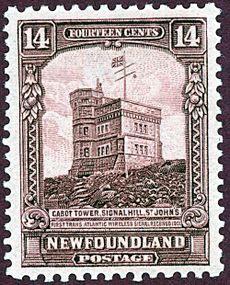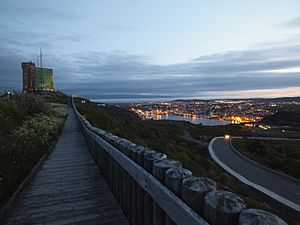Cabot Tower (St. John's) facts for kids
Quick facts for kids Cabot Tower |
|
|---|---|
 |
|
| General information | |
| Architectural style | Gothic Revival |
| Location | St. John's, Newfoundland and Labrador |
| Country | Canada |
| Coordinates | 47°34′12.05″N 52°40′54.38″W / 47.5700139°N 52.6817722°W |
| Groundbreaking | 1898 |
| Completed | 1900 |
| Height | 50 feet (15 m) |
| Design and construction | |
| Architect | William Howe Greene |
| Main contractor | Collin Wall, Bronson Wall, Courtney Head |
Cabot Tower is a famous tower located on Signal Hill in St. John's, Newfoundland and Labrador. Building the tower started in 1898. It was built to celebrate two big events. One was the 400th anniversary of John Cabot's trip to Newfoundland. The other was Queen Victoria's Diamond Jubilee, which marked her 60th year as queen.
A very important moment happened near the tower in 1901. Guglielmo Marconi received the first ever wireless message sent across the Atlantic Ocean! It was just the letter "S" in Morse Code, sent all the way from Poldhu, England. Today, Cabot Tower is a main part of the Signal Hill National Historic Site of Canada. You can find walking trails and a visitor center there.
Contents
History of Cabot Tower
Building Cabot Tower began in 1898 and finished in 1900. It was meant to honor both Queen Victoria's 60th year as queen and the 400th anniversary of John Cabot's journey to the New World. Even though it's a symbol of St. John's today, not everyone wanted it built at first.
Why Building the Tower Was Hard
St. John's had a tough time in the 1890s. A big fire destroyed most of the city in 1892. Then, the banks in Newfoundland failed in 1894. When a local man, Judge D.W. Prowse, suggested building the tower, some people thought it was a bad idea. One person said it was "like putting a silk hat on the head of a man who can't afford to buy a pair of boots." People wanted to support other projects more, like a new hospital wing.
How the Tower Was Used for Signalling
The tower was mainly used for sending messages with flags. The British military first used Signal Hill for this around 1704. A signalman would watch for ships coming to the city. When a ship was seen, he would use flags to show what kind of ship it was and where it was from. He would also fire a small cannon to alert people in the town.
By the late 1700s, a small fort called a blockhouse was built there. In the 1800s, signalling was mostly for merchants in St. John's. Cabot Tower was the last building used for flag signalling on Signal Hill. It continued to be used for this purpose until 1958.
Marconi's Wireless Messages
In 1933, a Marconi station opened on the second floor of Cabot Tower. This station worked until 1960. In 1920, one of the first wireless voice messages across the Atlantic was sent from here. People at the station could talk to the steamship Victoria, which was sailing from England. Today, a group called the Society of Newfoundland Radio Amateurs uses the tower for ham radio.
What Cabot Tower Looks Like
Cabot Tower sits at the highest point of Signal Hill. It looks out over the city and the ocean. The tower is built in a style called late-Gothic Revival. This means it looks like older, grand European buildings.
The tower is made of red sandstone. It has a two-story square base that is about 30 feet tall. On one corner, there's a taller, three-story tower that is 50 feet tall and has eight sides. The corners of the building have strong stone supports called buttresses. The main entrance is in the taller, octagonal part of the tower. The windows are rectangular with heavy stone tops.
The architect who designed Cabot Tower was William Howe Greene. He was a well-known architect from St. John's.




